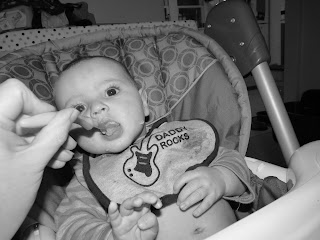I used 6 pears this time around, you can use as many as you like.
Step 1: Preheat oven to 375.
Step 2: After rinsing your fruit, cut the top and bottom off the pear. Cut it in half and scoop out the seeds.
Step 3: Place on cookie sheet and pour in about a cup and a half of water. Water will help steam the fruit.
Step 4: Place in oven and bake for about 45 minutes or until tender enough to poke a fork through.
Step 5: Pull the pears out of the oven and let cool enough to handle.
Step 6: With a spoon, scoop the fruit out of the skin or peel the skin off of the rest of the fruit.
This is what your pears should look like when peeled-
Step 7: Puree with immersion blender or food processor or food mill.
Step 8: Puree until smooth.
That's it! You are done. Remember you can use the same technique with apples, peaches, and squash. From here, put into your storage containers and freeze. You can season with some cinnamon, about a 1/2 tsp for 6 pears should be enough.
For a little flavor variety, mix pureed apple and pears, or pears and squash together.















